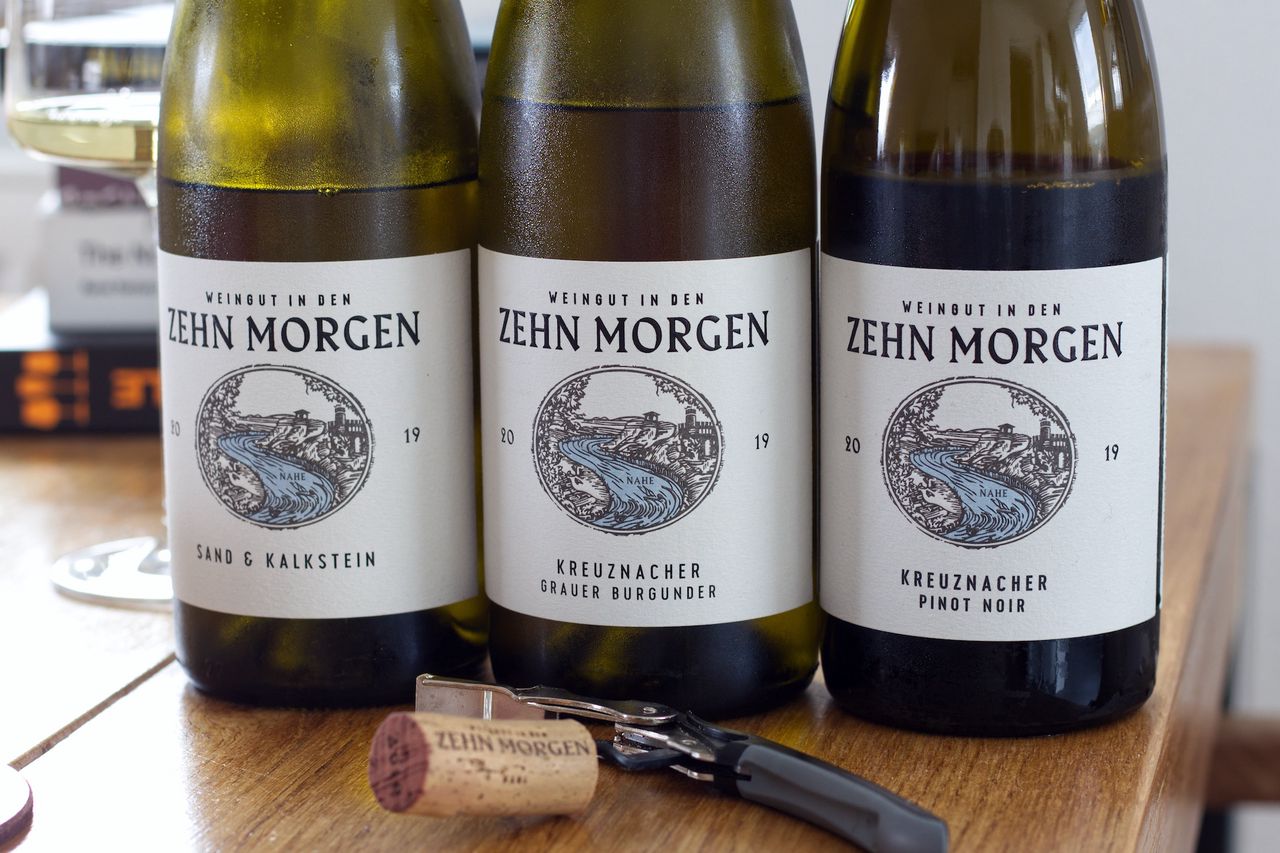Three Bottles In den Zehn Morgen
We drink from the Nahe from the winery In den Zehn Morgen a bottle of Grauer Burgunder 2019, a Sand und Kalkstein 2019 and a Kreuznacher Pinot Noir, also 2019.

A Morgen was once a common measure of area, which, according to Wikipedia, today corresponds to about 25 ares, or a quarter of a hectare. In the past, however, people did not take it so precisely and a Morgen was much more flexible in its measurement. The ten Morgen in the name would therefore be equivalent to 2.5 hectares, or much more or less, judging by the earlier flexibility. Not a very good guide, then, to the winery, which in any case cultivates much more than the 2.5 hectares corresponding to the name. In 2013, the farm manager Steffen Montigny took over the vineyard sites from the, to me not known, winery Ökonomierat August Anheuser around Bad Kreuznach. In 2016, the vineyards began to be cultivated in a natural way and since 2019, they have been working towards certification. Actually, the Nahe is Riesling area, which fills almost a third of the cultivated area. And of course, the Riesling is also the most important white grape variety in the winery In den Zehn Morgen. But I somehow didn’t feel like Riesling, so we drank a bottle of Sand & Kalkstein, a cuvée of Weissburgunder and Chardonnay, a bottle of Kreuznacher Grauer Burgunder and a Kreuznacher Pinot Noir. All three wines are from 2019 and these are all on Ortswein level, as an introduction to the winery’s range.
Let’s start with the Grauer Burgunder. There’s yellow, very ripe apple and some spice behind it. And clearly more acid than I would have expected. The apple also makes it to the tongue, but seems fresher and juicier. With Pinot Gris around 10 euros, my bar is not particularly high, the Pinot Gris after all is often what you get when you order white wine in the restaurant and the choice was between white wine and red wine. Because of that, I rarely drink Grauburgunder. However, I really like this one. I especially like the light creaminess and the confident acidity, which gives a lot of freshness and a slight edge. The edge it unfortunately loses a bit after a night. The wine becomes rounder but also a bit more boring, at least for my taste. So empty it on the first night.
The Sand und Kalkstein has more fruit to offer and also a very different fruit. There’s pome fruit too, but also peach and a bit of Capri ice cream. In the mouth comes spice, texture and orange. The acidity here is also orange rather than lemon, so it’s more soft and fruity and orange just rather than lemony, yellow and popping. It’s got a bit of a lemonade thing going on. What started here quite expressive in the nose becomes a little bit more restrained over the evening, but no less charming. And it stays that way on the second evening and works surprisingly well with a liverwurst bread.
The Pinot Noir is rather dark on the nose, spicy, slightly smoky with leather, wood, stone and dark berries. I do like the acidity here as well, which stands up well to the spice and smoke. The tannin is super soft and yet the wine seems powerful. I like this, but wouldn’t have blindly put it in the Pinot drawer and also think the wine works better in the fall around a campfire than in summer temperatures. On the other hand, the acidity gives so much freshness that I like drinking this right now as well. Chilled slightly and with a few hours of air contact comes more fruit. Now there’s cherry, lighter berries and a bit of sweet pastry. Then overnight a note of forest floor comes in. As the other windes, the Pinot seems a bit rounder and more harmonious overall a day after opening. Smoke and leather move a bit to the back, the fruit a bit to the front and with a fine lactic note this is really nice.
I wanted to complain first that I lack a little bit of depth in the wines, but on the one hand a lot happens especially in the Pinot with air and on the other hand, this is just the entry into the range and I find a very successful entry it is. No complaining to be had.